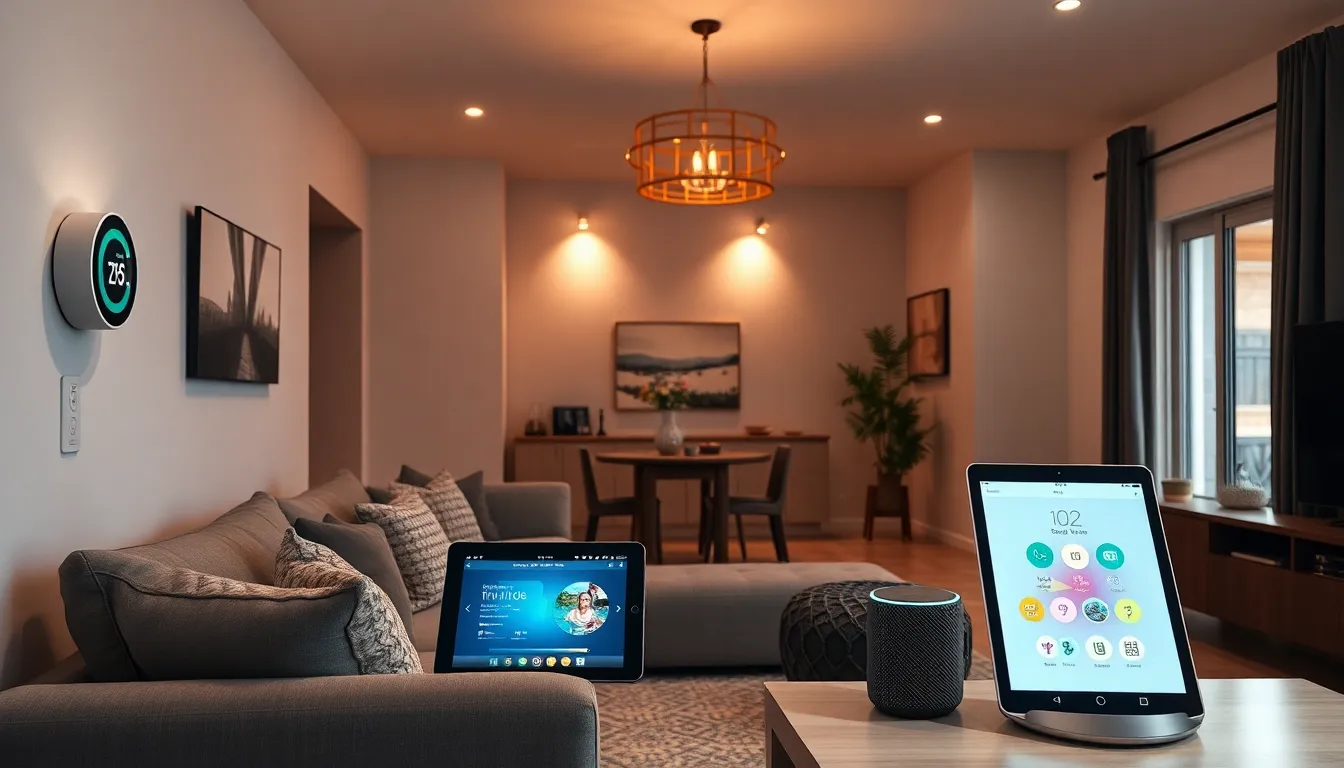Table of Contents
ToggleImagine waking up to the smell of freshly brewed coffee, the blinds gently lifting to let in the morning sun, and your favorite tunes playing softly in the background—all without lifting a finger. Sounds like a scene from a sci-fi movie, right? Welcome to the world of smart home automation systems, where convenience meets cutting-edge technology.
These systems don’t just make life easier; they’re like having a personal assistant who never sleeps and doesn’t mind your questionable taste in music. From controlling your lights and thermostat to securing your home with a simple voice command, smart automation transforms everyday living into a seamless experience. It’s time to embrace the future and turn your home into a tech-savvy sanctuary that practically runs itself. Who knew living in the future could be this much fun?
Overview of Smart Home Automation System
Smart home automation systems integrate various devices, enhancing the functionality and convenience of daily living. These systems allow homeowners to control lighting, security, heating, and appliances through smartphones or voice assistants. By utilizing interconnected devices, users can streamline their routines while maintaining energy efficiency.
Automation can include smart thermostats that adjust temperatures based on user preferences, security cameras that offer remote monitoring, and smart locks that enable keyless entry. Each component works cohesively, allowing for personalized settings and schedules. For instance, a typical evening setup might entail adjusting lights, locking doors, and lowering the thermostat with a single command.
Data indicates that homes equipped with automation systems can enhance energy savings by up to 30%. This benefit arises from the ability to monitor and adjust usage patterns conveniently. Additionally, homes integrate advanced security features through motion sensors and alerts, ensuring safety while users are away.
Compatibility plays a significant role in system effectiveness. Most modern smart home devices support platforms like Google Home and Amazon Alexa, enabling seamless integration and control. Users access these networks and manage their devices from a unified interface.
Smart home automation promotes not only convenience but also accessibility for individuals with disabilities or mobility challenges. Automated settings allow them to control their environment more easily, fostering independence.
Smart home automation systems offer a comprehensive approach to managing home environments with efficiency and ease. The technology represents a significant shift in how people interact with their living spaces, undeniably enhancing everyday routines.
Key Components of Smart Home Automation

Smart home automation systems rely on several key components to enhance functionality and user experience. Understanding these elements simplifies the selection process for homeowners.
Smart Devices
Smart devices form the backbone of any automation system. These gadgets include smart lights that adjust brightness automatically and smart thermostats that learn user preferences over time. Smart security cameras offer real-time monitoring, while smart locks provide keyless entry options. Many devices can connect to Wi-Fi, allowing remote access via smartphones. Various manufacturers produce these smart devices, ensuring compatibility with diverse automation systems. Integration with other devices enhances the overall usability of a smart home, creating customized settings and routines.
Central Hub
A central hub plays a crucial role in smart home automation systems. This device acts as the brain, enabling communication between various smart devices. Many hubs support protocols such as Zigbee or Z-Wave, allowing seamless integration of different brands. Homeowners can monitor and control their devices through a single interface, often accessible via mobile apps. Certain hubs also feature voice control compatibility with systems like Google Assistant or Amazon Alexa. Streamlining device management significantly enhances user experience, promoting convenience and efficiency for daily tasks.
Benefits of Smart Home Automation
Smart home automation systems significantly improve everyday living. These systems streamline daily tasks, making life more enjoyable and efficient.
Convenience
Homeowners experience unmatched convenience with smart home automation. Various tasks, from adjusting thermostat settings to controlling lighting, can occur through a smartphone or simple voice commands. Users can schedule routines to fit their needs, allowing appliances like coffee makers to start brewing at specific times. Smart home systems integrate with numerous devices, enabling control from any location. Many people appreciate the flexibility offered by remote access, which ensures comfort and ease at all times.
Energy Efficiency
Combat rising energy costs with smart home automation. Studies indicate that homes benefit from energy savings up to 30% through efficient management. Smart thermostats adjust temperatures based on user preferences and occupancy patterns, minimizing waste. Devices track energy usage, providing insights that help homeowners optimize consumption. Additionally, automated lighting systems ensure lights are only on when needed, further enhancing efficiency. This technology empowers individuals to create a more eco-friendly home while reducing utility expenses.
Security Enhancements
Enhance home security with smart automation features. Automated systems, including security cameras and smart locks, provide homeowners with peace of mind. Users receive real-time alerts for unusual activities, enabling quick responses. Remote access allows individuals to monitor their homes, ensuring safety regardless of their location. Integrated security cameras offer clear visibility, often with night vision capabilities. Smart locks enable controlled access, allowing friends and family entry without the need for traditional keys. This comprehensive approach to security fosters a safer living environment.
Popular Smart Home Automation Systems
Numerous smart home automation systems gain traction due to their functionality and user-friendly features. These systems offer robust solutions tailored to meet varying homeowner needs.
Comparison of Leading Brands
Amazon Alexa stands out as a leading option, integrating seamlessly with numerous third-party devices. Google Assistant excels in voice recognition and app compatibility, enhancing user experiences. Apple HomeKit provides strong security features, appealing to privacy-conscious users. Each brand offers unique strengths, influencing buyers’ choices based on personal preferences and device compatibility. Cost also plays a role, with various budgets accommodating different systems.
User Experiences
Users consistently praise smart home automation systems for enhanced convenience. Many enjoy controlling multiple devices with simple voice commands, removing traditional hassles. Security features, like real-time alerts and remote monitoring, contribute to peace of mind. Various reviews highlight energy savings through automated routines, with homeowners noting reductions in utility bills up to 30%. Adaptability to different lifestyles increases overall satisfaction. Overall experiences reflect a positive shift towards smarter living environments and efficient routines.
Smart home automation systems are revolutionizing how people interact with their living spaces. By integrating various devices and allowing seamless control through voice commands or smartphones, these systems enhance convenience and efficiency. Homeowners can enjoy energy savings and improved security while simplifying daily routines.
As technology continues to evolve, embracing smart home automation not only fosters a more comfortable lifestyle but also promotes sustainability and safety. With options available for every budget and preference, it’s easier than ever to transform any home into a smart home. Adopting this innovative technology is a step towards a future where everyday tasks become effortless and enjoyable.


